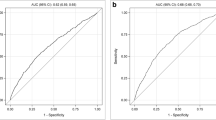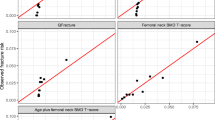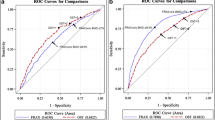Abstract
Decision to treat with an anti-osteoporotic drug should be based on individual fracture risk evaluation. We compared the discriminant value of four different screening strategies to identify elderly women with a risk of hip fracture greater than 20 per 1000 woman-years: (1) BMD screening alone, (2) quantitative ultrasound (QUS) screening alone, (3) QUS triage followed by BMD assessment for women with medium-low QUS parameters, and (4) selective BMD screening based on weight followed by clinical evaluation for women with medium-low BMD. The study population included 5910 women aged 75 years or older who participated to the EPIDOS (Epidemiologie de l’Ostéoporose) prospective study. Over an average of 3.7 (±0.8) years of follow-up, 231 women suffered a hip fracture, which corresponds to an average risk of 10.6 per 1000 woman-years. All strategies allow us to clearly distinguish a group at high risk of hip fracture (i.e. >20 per 1000 woman-years) from a group at low risk (i.e. below the average risk in the cohort). QUS screening alone has a very low sensitivity (15%). The strategy using QUS as a method of triage and that combining selective BMD and clinical assessment have a sensitivity equivalent to systematic BMD screening (around 35%), with less than 50% BMD examinations. The high-risk women identified by these two strategies are not the same. A simple algorithm combining QUS, BMD, and clinical risk assessment allows an increased number of high-risk women to be identified (21%), and thus improves the sensitivity (53%). With this combined strategy, women in the high-risk group have one chance in ten of having a hip fracture over the next 4 years, whereas women in the low risk group have only one chance in 40.


Similar content being viewed by others
References
Delmas PD (2002) Treatment of postmenopausal osteoporosis. Lancet 359:2018–2026
Kanis JA (2002) Diagnosis of osteoporosis and assessment of fracture risk. Lancet 359:1929–1936
Marshall D, Johnell O, Wedel H (1996) Meta-analysis of how well measures of bone mineral density predict occurrence of osteoporotic fractures. BMJ 312:1254–1259
Kanis JA, Black D, Cooper C et al. (2002) A new approach to the development of assessment guidelines for osteoporosis. Osteoporos Int 13:527–536
Jonsson B, Kanis J, Dawson A, Oden A, Johnell O (1999) Effect and offset of effect of treatments for hip fracture on health outcomes. Osteoporos Int 10:193–199
Dargent-Molina P, Poitiers F, Bréart G (2000) In elderly women weight is the best predictor of a vey low bone mineral density: evidence from the EPIDOS study. Osteoporos Int 11:881–888
Dargent-Molina P, Douchin MN, Cormier C, Meunier PJ, Bréart G (2002) Use of clinical risk factors in elderly women with low bone mineral density to identify women at higher risk of hip fracture: the EPIDOS prospective study. Osteoporos Int 13:593–599
Glüer CC, Hans D (1999) How to use ultrasound for risk assessment: a need for defining strategies. Osteoporos Int 9:193–195
Torgerson DJ (1998) Is there a future for non-menopausal screening strategeis for osteoporosis prevention? Osteoporos Int Suppl. 1:S57–S61
Dargent-Molina P, Favier F, Grandjean H et al. (1996) Fall-related factors and risk of hip fracture: the EPIDOS prospective study. Lancet 348:145–149
Hans D, Dargent-Molina P, Schott AM et al. (1996) Ultrasonographic heel measurements to predict hip fracture in elderly women: the EPIDOS prospective study. Lancet 348:511–514
Black DM, Cummings SR, Karpf DB et al. (1996) Randomised trial of effect of alendronate on risk of fracture in women with existing vertebral fractures. Lancet 348:1535–1541
Cummings SR, Black DM, Thompson DE et al. (1998) Effect of alendronate on risk of fracture in women with low bone density but without vertebral fractures. Results from the Fracture Intervention Trial. JAMA 280:2077–2082
McClung MR, Geusens P, Miller PD et al. (2001) Effect of risedronate on the risk of hip fracture in elderly women. N Engl J Med 344:333–340
Neer RM, Arnaud CD, Zanchetta JR et al. (2001) Effect of parathyroid hormone (1–34) on fractures and bone mineral density in postmenopausal women with osteoporosis. N Engl J Med 344:1434–1441
Glüer CC (1997) Quantitative ultrasound techniques for the assessment of osteoporosis: expert agreement on current status. J Bone Miner Res 12:1280–1288
Gonnelli S, Cepollaro C, Montagnani A et al. (2002) Heel ultrasonography in monitoring alendronate therapy: a four-year longitudinal study. Osteoporos Int 13:415–421
Cummings SR, Palermo L, Browner WS et al. (2000) Monitoring osteoporosis therapy with bone densitometry. JAMA 283:1318–1321
Chapuy MC, Schott AM, Garnero P, Hans D, Delmas PD, Meunier PJ, and the EPIDOS Study Group (1996) Healthy elderly French women living at home have secondary hyperparathyroidism and high bone turnover in winter. J Clin Endocrinol Metab 81:1129–1133
Scharla SH (1998) Prevalence of subclinical vitamin D deficiency in different European countries. Osteoporos Int Suppl 8:S7–S12
Bauer DC, Glüer CC, Cauley JA et al. (1997) Broadband ultrasound attenuation predicts fractures strongly and independently of densitometry in older women. Arch Int Med 157:629–634
Lydick E, Cook K, Turpin J et al. (1998) Development and validation of a simple questionnaire to facilitate identification of women likely to have a low bone density. Am J Managed Care 4:37–48
Cadetta SM, Jagal SB, Kreiger N et al. (2000) Development and validation of the osteoporosis risk assessment instrument to facilitate selection of women for bone densitometry. Can Med Assoc J 162:1289–1294
Burger H, De Laet C, Weel A, Hofman A, Pols H (1999) Added value of bone mineral density in hip fracture risk scores. Bone 25:369–374
Koh LKH, Ben Sedrine W, Torralba TP et al. (2001) A simple tool to identify Asian women at increased risk of osteoporosis. Osteoporos Int 12:699–705
Black DM, Steinbuch M, Palermo L, Dargent-Molina P, Lindsay R, Hoseyni MS, Johnell O (2001) An assessment tool for predicting fracture risk in postmenopausal women. Osteoporos Int 12:519–528
McGrother CW, Donaldson MMK, Clayton D, Abrams KR, Clarke M (2002) Evaluation of a hip fracture risk score for assessing elderly women: the Melton Osteoporotic Fracture (MOF) study. Osteoporos Int 13:89–96
Acknowledgements
The EPIDOS study was supported by a contract INSERM-MSD-Chibret.
Author information
Authors and Affiliations
Consortia
Corresponding author
Additional information
Members of the EPIDOS Study Group: Coordinators: G. Bréart, P. Dargent-Molina(epidemiology), P.J. Meunier, A.M. Schott (clinical aspects), D. Hans (bone densitometry and ultrasound quality control), P.D. Delmas (biochemistry). Principal investigators (center): C. Baudoin, J.L. Sebert (Amiens); M.C. Chapuy, A.M. Schott (Lyon); F. Favier, C. Marcelli (Montpellier); E. Hausherr, C.J. Menkes, C. Cormier (Paris); H. Grandjean, C. Ribot (Toulouse)
Rights and permissions
About this article
Cite this article
Dargent-Molina, P., Piault, S., Bréart, G. et al. A comparison of different screening strategies to identify elderly women at high risk of hip fracture: results from the EPIDOS prospective study. Osteoporos Int 14, 969–977 (2003). https://doi.org/10.1007/s00198-003-1506-0
Received:
Accepted:
Published:
Issue Date:
DOI: https://doi.org/10.1007/s00198-003-1506-0




